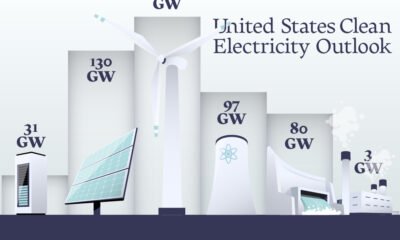2024 U.S. Clean Electricity Outlook
This was originally posted on the Decarbonization Channel. Subscribe to the free mailing list to be the first to receive decarbonization-related visualizations with a focus on the U.S. power sector.
As the world seeks sustainable energy solutions, the U.S. has the opportunity to lead the charge in the global shift toward clean electricity.
But what kind of progress can the country expect in the upcoming year?
To find out, we partnered with the National Public Utilities Council to visualize the projected 2024 electricity generation capacity of clean energy technologies in the U.S., using data from the U.S. Energy Information Administration (EIA).
The Rise of Battery Storage and Solar Power
Looking ahead to 2024, U.S. generation capacity projections unveil a promising trajectory for battery storage and solar power. Battery storage is projected to grow by 82% compared to 2023 projections, while solar is projected to grow by 40%.
Growth is also expected for wind power, albeit at a slower rate (5%) due to higher costs and permitting challenges, especially for offshore projects.
| Electricity Generation Capacity Projections | 2023 | 2024 | Change |
|---|---|---|---|
| Battery Storage | 17 GW | 31 GW | +82% |
| Solar | 93 GW | 130 GW | +40% |
| Wind | 149 GW | 156 GW | +5% |
| Nuclear | 96 GW | 97 GW | +1% |
| Geothermal | 3 GW | 3 GW | 0% |
| Hydro | 80 GW | 80 GW | 0% |
As illustrated in the table above, the EIA projects a modest year for the rest of the major clean electricity sources in the nation, with nuclear expected to eke out a lackluster 1% growth, while hydro and geothermal remain unchanged.
Overall, these projections underscore a diversification of the U.S. energy portfolio, with a pronounced emphasis on renewables and energy storage. The growth in battery storage capacity, specifically, underscores efforts to overcome the intermittency challenges of renewables, ultimately ensuring a reliable and emission-free power supply in the country.
The Broader U.S. Power Sector in 2024
Beyond capacity projections, let’s also take a look at some projected trends related to the broader U.S. power sector in 2024.
- U.S. daily electricity generation is projected to grow by 3% between 2023 and 2024, reflecting an increasing demand for power in the country.
- Renewables are set to claim an even larger slice of the U.S. electricity mix in 2024, rising from 22% in 2023 to 24%.
- Electricity production from coal is projected to decline by 9% as the country continues its move away from the emission-intensive energy source.
- Despite the country’s projected growth in clean electricity capacity, total U.S. energy-related emissions are projected to drop by 0.1% in 2024.
All in all, the 2024 landscape of the U.S. power sector signifies progress with increased renewables and heightened electricity generation. However, the marginal dip in emissions emphasizes the need to ramp-up country-wide efforts to meet the goal of a net-zero future


